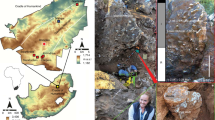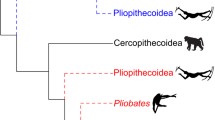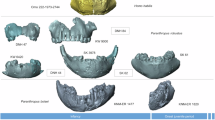Abstract
The morphology of the nasal bones and their articulations with the adjoining frontal and maxillary bones have recently been reported in Nature and elsewhere1–3 to be diagnostic of hominoid taxa, and cladistic analysis based on these features has been used to assign two immature Plio-Pleistocene hominoids (AL 333-105 and Taung) to different lineages (Paranthropus and Homo, respectively). Because earlier studies4–10 had established that hominoid crania are highly variable intraspecifically, it seemed desirable to try to replicate the study reporting a consistently different pattern for each hominoid taxon3. My results show extensive polymorphism in the nasal region within every taxon of extant pongids, including several rather clear examples, in extant Pan troglodytes, of that recently hypothesized to be a 'paranthropine' pattern3. These findings underscore the substantial risks inherent in cladistic analyses using very restricted character sets to assign individual specimens to particular taxa.
This is a preview of subscription content, access via your institution
Access options
Subscribe to this journal
Receive 51 print issues and online access
$199.00 per year
only $3.90 per issue
Buy this article
- Purchase on SpringerLink
- Instant access to full article PDF
Prices may be subject to local taxes which are calculated during checkout
Similar content being viewed by others
References
1. Olson, T. R. J. Hum. Evol. 7, 159–178 (1978). 2. Olson, T. R. in Ancestors: The Hard Evidence (ed. Delson, E.) 102–119 (Liss, New York, 1985). 3. Olson, T. R. Nature 316, 539–540 (1985). 4. Coolidge, H. J. Mem. Mus. Comp. Zoo/., Harvard L, 293–381 (1929). 5. Randall, F. E. Hum. Biol. 15, 236–254 (1943). 6. Randall, F. E. Hum. Biol. 15, 307–337 (1943). 7. Randall, F. E. Hum. Biol. 16, 23–76 (1944). 8. Schultz, A. H. Contrib. Embryol 170, Carnegie Inst. Washington Publ. 518, 1–63 (1940). 9. Schultz, A. H. Contrib. Embryol. 182, Carnegie Inst. Washington Publ. 525, 57–110 (1941). 10. Tobias, P. V. The Brain in Hominoid Evolution (Columbia, New York, 1971). 11. Walker, A., Leakey, R. E., Harris, J. M. & Brown, F. H. Nature 322, 517–522 (1986). 12. Walker, A. & Leakey, R. E. Am. J. phys. Anthrop. (in the press).
Author information
Authors and Affiliations
Rights and permissions
About this article
Cite this article
Eckhardt, R. Hominoid nasal region polymorphism and its phylogenetic significance. Nature 328, 333–335 (1987). https://doi.org/10.1038/328333a0
Received:
Accepted:
Issue date:
DOI: https://doi.org/10.1038/328333a0
This article is cited by
-
Molecular and morphological congruence in hominoid trans-species polymorphisms
Human Evolution (1995)
-
Australopithecines: Ancestors of the African Apes?
Human Evolution (1994)
-
Australopithecus afarensis and the single species hypothesis
Primates (1991)
-
African ape ancestry
Human Evolution (1990)
-
Nasal region polymorphism frequencies in the FrankfurtPan troglodytes verus collection
Human Evolution (1988)



